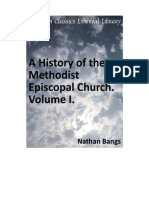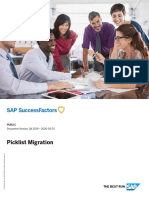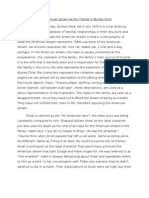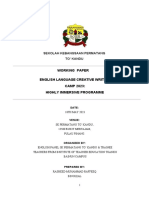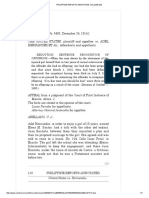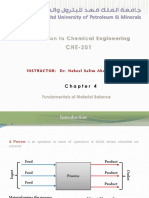Professional Documents
Culture Documents
Employee Retainment Prediction Using Text Mining and Opinion Mining 1
Copyright
Available Formats
Share this document
Did you find this document useful?
Is this content inappropriate?
Report this DocumentCopyright:
Available Formats
Employee Retainment Prediction Using Text Mining and Opinion Mining 1
Copyright:
Available Formats
Volume 3, Issue 5, May – 2018 International Journal of Innovative Science and Research Technology
ISSN No:-2456-2165
Employee Retainment Prediction using Text Mining
and Opinion Mining
Vasudeva Roa P V1, Shreya2, Zafeera Banu3, Shifali Shetty4, Princia Honey Kundar5
1
(Assistant Professor, Dept. of Information Science Engineering, Sahyadri College of Engineering and Management,
Karnataka, India)
2,3,4,5
(Student, Dept. of Information Science Engineering, Sahyadri College of Engineering and Management,
Karnataka, India)
Abstract:- Performance Monitoring is one of the most employee performance is not a easy task. Earlier it was done
important issues of an organization today. In order to manually which was time consuming and sometimes it
overcome the difficulties of manually monitoring the could be biased. In order to overcome such problems several
performance of an employee, this system has been systems where introduced one of which is Employee
introduced. It enables the monitoring of employee Retainment Prediction System.
perspective based on various aspects related to an
organization. This system takes feedback from the In an organization, the employees are divided into
employee in the form of number of questionnaires. Based different teams and each team has both team members as
on the feedback given by the employee the higher well as team leader. In an Employee Retainment Prediction
authority can estimate the chances of him quitting the System, the feedback is taken from both team member and
organization. Taking into account the probability of team leader. The team member gives the feedback on his
employee leaving the company, appropriate actions can perspective about the organization and team leader gives the
be taken. feedback about the performance of respective team member.
The feedback is taken in the form of several questionnaires’
Keywords:- organization, feedback, questionnaires, as well as a comment box.
comment.
I. INTRODUCTION II. ARCHITECTURE OF THE PROPOSED
SYSTEM
Opinion Mining is a process of determining the human
behavior based on reviews and feedback. Once if you Initially, the team member has to login to the
understand how the human feel after analyzing the reviews Employee Retainment System by entering his user ID,
you can identify what he likes and dislikes. Opinion Mining password and type. If the details are valid then the feedback
can be widely used in determining the movie reviews, page is displayed where he can give the feedback on his
reviews of product marketing, employee performance view about the organization else the error message will be
monitoring, fake review detection etc. It has methods such displayed. After this he can logout from system. The team
as classification, clustering, similarity checking and so on. leader login procedure is similar to that of team member.
Sometimes Opinion Mining is also known as Sentiment Once the team member and team leader are done with
analysis. giving feedback, now the manager can view the result of the
feedback. In order to view the result, the manager has to
Text Mining is a process of extraction of useful data login using his user ID, password and type. If the details are
from large amount of text. In Text Mining, high quality data valid, results will be displayed to him, else the error
is derived from large amount of data by pattern and trend message will pop up.
devising through the means such as statistical pattern
learning. The objective of Text Mining is to exploit the large The feedback given by the team member, team leader
amount of text available in order to discover new patterns and manager will be stored in the database. The feedback is
and trends in data. For Example: Years ago people in given in the form of certain questions as well as a comment
various sector used pen and paper to store data, as the box. The feedback given as questions contribute 90% of the
technology evolved, everything has become digital which result and remaining 10% is of the comment. The questions
results in the creation of large amount of text document. In are answered in the form of yes or no. Here the number of
order to manage and extract the useful data from the large no is represented by z (i.e., zero) and the number of yes is
amount of text, Text Mining is used. represented by o (i.e., one). Each time the yes is clicked o
gets incremented and each time a no is clicked z is
Performance Monitoring of an employee plays a vital incremented. Finally the number of o will be multiplied by
role in the growth of an organization. In order to meet the 10, in order to get the percentage.
goals of an organization, evaluation of employee
performance is very important. But determining the
IJISRT18MY596 www.ijisrt.com 706
Volume 3, Issue 5, May – 2018 International Journal of Innovative Science and Research Technology
ISSN No:-2456-2165
Fig 1:- Architecture Diagram for Employee Retainment System
The comments given by the team member and team placed in a separate file. Compare the words with the
leader contribute the 10% of the result. Initially, the test set and find which words are the positive and negative.
punctuations present in the comments is replaced by the
whitespace. The comment is then divided into parts and
Fig 2:- Modular Diagram for Employee Retainment System
feedback. Here the x-axis represents the number of
III. RESULT AND ANALYSIS words and the y-axis represent the time in milliseconds. We
can see that as the number of word increases, the time taken
The following graph represents the processing time of to process gradually increase.
the Employee Retainment Prediction system based on the
number of words present in the comment section of the
Fig 3:- Graph to represent the processing time of the Employee Retainment Prediction System
IJISRT18MY596 www.ijisrt.com 707
Volume 3, Issue 5, May – 2018 International Journal of Innovative Science and Research Technology
ISSN No:-2456-2165
Fig 4:- Screenshot of Home Page
Fig 7:- Screenshot for Team Leader Feedback
The figure above shows the screenshot of how the
team member and team leader gives feedback. The feedback
is in the form of certain questions and the comment.
Fig 5:- Screenshot of login page
The figure 4 represents the home page of the
Employee Retainment Prediction System. The home page
consists of home and login. The figure 5: represents the
login page of the system. The login page consists of user ID,
password and type. Here the team member, team leader
and manager login based on their details.
Fig 8:- Screenshot of viewing Feedback
Fig 9:- Screenshot of Final Result
The figure 8 represents the page that is displayed to the
Fig 6:- Screenshot for Team Member Feedback manager where he can view the end result. The figure 9
represents the end page that displays the final result to the
manager with respect to which he makes the decisions
IJISRT18MY596 www.ijisrt.com 708
Volume 3, Issue 5, May – 2018 International Journal of Innovative Science and Research Technology
ISSN No:-2456-2165
IV. CONCLUSION
This paper focuses on estimating the employee
feedback on his perspective about organization along with
the feedback of team leader based on respective employee’s
performance in order to obtain the average feedback. This
overall feedback enables the manager to make the
appropriate decision. The feedback is displayed in the form
of percentage as well as the in the form of good, bad or
average. Our system can currently be used in Computers or
laptops, further it is intended to be used in smart phones as
an application which makes its use more easier.
REFERENCES
Journal Papers:
[1] V. Suriyakumari and A. Vijaya Kathiravan , “An
Ubiquitous Domain Driven Data Mining Approach For
Performance Monitoring in Virtual Organization Using
360 Degree Data Mining And Opinion Mining” 2013
International Conference on Pattern Recognition,
Informatics and Mobile Engineering (PRIME), ISBN c :
978-1-4673- 5845-3.
[2] Manoj Kumar Das, Binayak Padhy and Brojo Kishore
Mishra, “Opinion Mining and Sentiment classification:
A Review”, 2017 International Conference on Inventive
Systems and Control (ICISC), ISBN c : 978-1-5090-
4715-4.
[3] Iyer Aurobind Venkat Kumar and Sanatkumar
Jayantibhai Kondhol Shardaben, “Comparative Study of
data Mining Clustering Algorithms” 2016 International
Conference on Data Science and Engineering(ICDSE),
ISBN c : 978-1-5090-1281-7.
[4] Francis F. Balahadia, Ma. Corazon G. Fernando and
Irish C. Juanantas, “Teacher’s Performance Evaluation
Tool Using Opinion Mining with Sentiment Analysis”,
2016 Region 10 Symposium(TENSYMP), ISBN c
:978-1-5090-0931-2.
[5] Amani A. Abed and Alaa M. El-Halees “Detecting
Subjectivity in Staff Performance Appraisals by Using
Text Mining : Teacher’s Appraisals of Palestinian
Government Case Study ”,2017 Palestinian
International Conference on Information and
Communication Technology(PICICT), ISBN c :978-1-
5090-6538-7.
[6] Kavitha Karun A, Mintu Philip, Lubna Ki
,“Comparative Analysis of Similarity Measures in
Document Clustering” ,2013 International Conference
on Green Computing, Communication and
Conservation of Energy (ICGCE), ISBN c :978-1-4673-
6126-2.
[7] Tejshree D. Chungade, Prof. Shweta Kharat,
“Employee Performance Assessment in Virtual
Organization using Domain-Driven Data Mining and
Sentiment Analysis”,2017 International Conference on
Innovational in Information Embedded and
Communication Systems 978-1-5090-3294-5.
[8] Sohail Ahmed, Xing KE, “Human Resource
Management: Employees Career Development Impact
on Organizational Performance”,2016 978-1-5090-
2842-9.
IJISRT18MY596 www.ijisrt.com 709
You might also like
- The Sympathizer: A Novel (Pulitzer Prize for Fiction)From EverandThe Sympathizer: A Novel (Pulitzer Prize for Fiction)Rating: 4.5 out of 5 stars4.5/5 (119)
- Devil in the Grove: Thurgood Marshall, the Groveland Boys, and the Dawn of a New AmericaFrom EverandDevil in the Grove: Thurgood Marshall, the Groveland Boys, and the Dawn of a New AmericaRating: 4.5 out of 5 stars4.5/5 (266)
- The Little Book of Hygge: Danish Secrets to Happy LivingFrom EverandThe Little Book of Hygge: Danish Secrets to Happy LivingRating: 3.5 out of 5 stars3.5/5 (399)
- A Heartbreaking Work Of Staggering Genius: A Memoir Based on a True StoryFrom EverandA Heartbreaking Work Of Staggering Genius: A Memoir Based on a True StoryRating: 3.5 out of 5 stars3.5/5 (231)
- Grit: The Power of Passion and PerseveranceFrom EverandGrit: The Power of Passion and PerseveranceRating: 4 out of 5 stars4/5 (587)
- Never Split the Difference: Negotiating As If Your Life Depended On ItFrom EverandNever Split the Difference: Negotiating As If Your Life Depended On ItRating: 4.5 out of 5 stars4.5/5 (838)
- The Subtle Art of Not Giving a F*ck: A Counterintuitive Approach to Living a Good LifeFrom EverandThe Subtle Art of Not Giving a F*ck: A Counterintuitive Approach to Living a Good LifeRating: 4 out of 5 stars4/5 (5794)
- Team of Rivals: The Political Genius of Abraham LincolnFrom EverandTeam of Rivals: The Political Genius of Abraham LincolnRating: 4.5 out of 5 stars4.5/5 (234)
- Shoe Dog: A Memoir by the Creator of NikeFrom EverandShoe Dog: A Memoir by the Creator of NikeRating: 4.5 out of 5 stars4.5/5 (537)
- The World Is Flat 3.0: A Brief History of the Twenty-first CenturyFrom EverandThe World Is Flat 3.0: A Brief History of the Twenty-first CenturyRating: 3.5 out of 5 stars3.5/5 (2219)
- The Emperor of All Maladies: A Biography of CancerFrom EverandThe Emperor of All Maladies: A Biography of CancerRating: 4.5 out of 5 stars4.5/5 (271)
- The Gifts of Imperfection: Let Go of Who You Think You're Supposed to Be and Embrace Who You AreFrom EverandThe Gifts of Imperfection: Let Go of Who You Think You're Supposed to Be and Embrace Who You AreRating: 4 out of 5 stars4/5 (1090)
- The Hard Thing About Hard Things: Building a Business When There Are No Easy AnswersFrom EverandThe Hard Thing About Hard Things: Building a Business When There Are No Easy AnswersRating: 4.5 out of 5 stars4.5/5 (344)
- Her Body and Other Parties: StoriesFrom EverandHer Body and Other Parties: StoriesRating: 4 out of 5 stars4/5 (821)
- Hidden Figures: The American Dream and the Untold Story of the Black Women Mathematicians Who Helped Win the Space RaceFrom EverandHidden Figures: The American Dream and the Untold Story of the Black Women Mathematicians Who Helped Win the Space RaceRating: 4 out of 5 stars4/5 (894)
- Elon Musk: Tesla, SpaceX, and the Quest for a Fantastic FutureFrom EverandElon Musk: Tesla, SpaceX, and the Quest for a Fantastic FutureRating: 4.5 out of 5 stars4.5/5 (474)
- The Unwinding: An Inner History of the New AmericaFrom EverandThe Unwinding: An Inner History of the New AmericaRating: 4 out of 5 stars4/5 (45)
- The Yellow House: A Memoir (2019 National Book Award Winner)From EverandThe Yellow House: A Memoir (2019 National Book Award Winner)Rating: 4 out of 5 stars4/5 (98)
- On Fire: The (Burning) Case for a Green New DealFrom EverandOn Fire: The (Burning) Case for a Green New DealRating: 4 out of 5 stars4/5 (73)
- Assignment of Constitutional Law Topic-State Under Article 12Document21 pagesAssignment of Constitutional Law Topic-State Under Article 12Saba AfreenNo ratings yet
- Best Practice in Analytical Method ValidationDocument24 pagesBest Practice in Analytical Method ValidationJarvis MurrayNo ratings yet
- A History of The Methodist Episcopal Church Volume I (Nathan D.D.bangs)Document244 pagesA History of The Methodist Episcopal Church Volume I (Nathan D.D.bangs)Jaguar777xNo ratings yet
- Guide 2017Document48 pagesGuide 2017Kleberson MeirelesNo ratings yet
- Magnetic Effects of Current PDFDocument32 pagesMagnetic Effects of Current PDFAdarshNo ratings yet
- On The Metres of Poetry and Related Matters According To AristotleDocument61 pagesOn The Metres of Poetry and Related Matters According To AristotleBart MazzettiNo ratings yet
- Difference Between Heat and TemperatureDocument8 pagesDifference Between Heat and TemperatureMarivic MirandaNo ratings yet
- An Analysis on Mental Health Issues among IndividualsDocument6 pagesAn Analysis on Mental Health Issues among IndividualsInternational Journal of Innovative Science and Research TechnologyNo ratings yet
- Harnessing Open Innovation for Translating Global Languages into Indian LanuagesDocument7 pagesHarnessing Open Innovation for Translating Global Languages into Indian LanuagesInternational Journal of Innovative Science and Research TechnologyNo ratings yet
- Diabetic Retinopathy Stage Detection Using CNN and Inception V3Document9 pagesDiabetic Retinopathy Stage Detection Using CNN and Inception V3International Journal of Innovative Science and Research TechnologyNo ratings yet
- Investigating Factors Influencing Employee Absenteeism: A Case Study of Secondary Schools in MuscatDocument16 pagesInvestigating Factors Influencing Employee Absenteeism: A Case Study of Secondary Schools in MuscatInternational Journal of Innovative Science and Research TechnologyNo ratings yet
- Exploring the Molecular Docking Interactions between the Polyherbal Formulation Ibadhychooranam and Human Aldose Reductase Enzyme as a Novel Approach for Investigating its Potential Efficacy in Management of CataractDocument7 pagesExploring the Molecular Docking Interactions between the Polyherbal Formulation Ibadhychooranam and Human Aldose Reductase Enzyme as a Novel Approach for Investigating its Potential Efficacy in Management of CataractInternational Journal of Innovative Science and Research TechnologyNo ratings yet
- The Making of Object Recognition Eyeglasses for the Visually Impaired using Image AIDocument6 pagesThe Making of Object Recognition Eyeglasses for the Visually Impaired using Image AIInternational Journal of Innovative Science and Research TechnologyNo ratings yet
- The Relationship between Teacher Reflective Practice and Students Engagement in the Public Elementary SchoolDocument31 pagesThe Relationship between Teacher Reflective Practice and Students Engagement in the Public Elementary SchoolInternational Journal of Innovative Science and Research TechnologyNo ratings yet
- Dense Wavelength Division Multiplexing (DWDM) in IT Networks: A Leap Beyond Synchronous Digital Hierarchy (SDH)Document2 pagesDense Wavelength Division Multiplexing (DWDM) in IT Networks: A Leap Beyond Synchronous Digital Hierarchy (SDH)International Journal of Innovative Science and Research TechnologyNo ratings yet
- Comparatively Design and Analyze Elevated Rectangular Water Reservoir with and without Bracing for Different Stagging HeightDocument4 pagesComparatively Design and Analyze Elevated Rectangular Water Reservoir with and without Bracing for Different Stagging HeightInternational Journal of Innovative Science and Research TechnologyNo ratings yet
- The Impact of Digital Marketing Dimensions on Customer SatisfactionDocument6 pagesThe Impact of Digital Marketing Dimensions on Customer SatisfactionInternational Journal of Innovative Science and Research TechnologyNo ratings yet
- Electro-Optics Properties of Intact Cocoa Beans based on Near Infrared TechnologyDocument7 pagesElectro-Optics Properties of Intact Cocoa Beans based on Near Infrared TechnologyInternational Journal of Innovative Science and Research TechnologyNo ratings yet
- Formulation and Evaluation of Poly Herbal Body ScrubDocument6 pagesFormulation and Evaluation of Poly Herbal Body ScrubInternational Journal of Innovative Science and Research TechnologyNo ratings yet
- Advancing Healthcare Predictions: Harnessing Machine Learning for Accurate Health Index PrognosisDocument8 pagesAdvancing Healthcare Predictions: Harnessing Machine Learning for Accurate Health Index PrognosisInternational Journal of Innovative Science and Research TechnologyNo ratings yet
- The Utilization of Date Palm (Phoenix dactylifera) Leaf Fiber as a Main Component in Making an Improvised Water FilterDocument11 pagesThe Utilization of Date Palm (Phoenix dactylifera) Leaf Fiber as a Main Component in Making an Improvised Water FilterInternational Journal of Innovative Science and Research TechnologyNo ratings yet
- Cyberbullying: Legal and Ethical Implications, Challenges and Opportunities for Policy DevelopmentDocument7 pagesCyberbullying: Legal and Ethical Implications, Challenges and Opportunities for Policy DevelopmentInternational Journal of Innovative Science and Research TechnologyNo ratings yet
- Auto Encoder Driven Hybrid Pipelines for Image Deblurring using NAFNETDocument6 pagesAuto Encoder Driven Hybrid Pipelines for Image Deblurring using NAFNETInternational Journal of Innovative Science and Research TechnologyNo ratings yet
- Terracing as an Old-Style Scheme of Soil Water Preservation in Djingliya-Mandara Mountains- CameroonDocument14 pagesTerracing as an Old-Style Scheme of Soil Water Preservation in Djingliya-Mandara Mountains- CameroonInternational Journal of Innovative Science and Research TechnologyNo ratings yet
- A Survey of the Plastic Waste used in Paving BlocksDocument4 pagesA Survey of the Plastic Waste used in Paving BlocksInternational Journal of Innovative Science and Research TechnologyNo ratings yet
- Hepatic Portovenous Gas in a Young MaleDocument2 pagesHepatic Portovenous Gas in a Young MaleInternational Journal of Innovative Science and Research TechnologyNo ratings yet
- Design, Development and Evaluation of Methi-Shikakai Herbal ShampooDocument8 pagesDesign, Development and Evaluation of Methi-Shikakai Herbal ShampooInternational Journal of Innovative Science and Research Technology100% (3)
- Explorning the Role of Machine Learning in Enhancing Cloud SecurityDocument5 pagesExplorning the Role of Machine Learning in Enhancing Cloud SecurityInternational Journal of Innovative Science and Research TechnologyNo ratings yet
- A Review: Pink Eye Outbreak in IndiaDocument3 pagesA Review: Pink Eye Outbreak in IndiaInternational Journal of Innovative Science and Research TechnologyNo ratings yet
- Automatic Power Factor ControllerDocument4 pagesAutomatic Power Factor ControllerInternational Journal of Innovative Science and Research TechnologyNo ratings yet
- Review of Biomechanics in Footwear Design and Development: An Exploration of Key Concepts and InnovationsDocument5 pagesReview of Biomechanics in Footwear Design and Development: An Exploration of Key Concepts and InnovationsInternational Journal of Innovative Science and Research TechnologyNo ratings yet
- Mobile Distractions among Adolescents: Impact on Learning in the Aftermath of COVID-19 in IndiaDocument2 pagesMobile Distractions among Adolescents: Impact on Learning in the Aftermath of COVID-19 in IndiaInternational Journal of Innovative Science and Research TechnologyNo ratings yet
- Studying the Situation and Proposing Some Basic Solutions to Improve Psychological Harmony Between Managerial Staff and Students of Medical Universities in Hanoi AreaDocument5 pagesStudying the Situation and Proposing Some Basic Solutions to Improve Psychological Harmony Between Managerial Staff and Students of Medical Universities in Hanoi AreaInternational Journal of Innovative Science and Research TechnologyNo ratings yet
- Navigating Digitalization: AHP Insights for SMEs' Strategic TransformationDocument11 pagesNavigating Digitalization: AHP Insights for SMEs' Strategic TransformationInternational Journal of Innovative Science and Research Technology100% (1)
- Drug Dosage Control System Using Reinforcement LearningDocument8 pagesDrug Dosage Control System Using Reinforcement LearningInternational Journal of Innovative Science and Research TechnologyNo ratings yet
- The Effect of Time Variables as Predictors of Senior Secondary School Students' Mathematical Performance Department of Mathematics Education Freetown PolytechnicDocument7 pagesThe Effect of Time Variables as Predictors of Senior Secondary School Students' Mathematical Performance Department of Mathematics Education Freetown PolytechnicInternational Journal of Innovative Science and Research TechnologyNo ratings yet
- Formation of New Technology in Automated Highway System in Peripheral HighwayDocument6 pagesFormation of New Technology in Automated Highway System in Peripheral HighwayInternational Journal of Innovative Science and Research TechnologyNo ratings yet
- ENSC1001 Unit Outline 2014Document12 pagesENSC1001 Unit Outline 2014TheColonel999No ratings yet
- MST Components Enable New Nanosatellite CapabilitiesDocument10 pagesMST Components Enable New Nanosatellite CapabilitiesibrahimwngNo ratings yet
- Patient Medication ProfileDocument4 pagesPatient Medication ProfileLaura HernandezNo ratings yet
- Simple Steel BridgeDocument2 pagesSimple Steel BridgeAnonymous 1GK9Hxp5YKNo ratings yet
- MCQ'S: Deflation Inflation Recession None of The AboveDocument18 pagesMCQ'S: Deflation Inflation Recession None of The Abovesushainkapoor photoNo ratings yet
- Document 2Document7 pagesDocument 2rNo ratings yet
- SafeNet Ikey4000 PB (En) WebDocument2 pagesSafeNet Ikey4000 PB (En) WebbasharaccountNo ratings yet
- ART. Dworkin - in Praise of Theory PDFDocument16 pagesART. Dworkin - in Praise of Theory PDFmaiasilva70No ratings yet
- Vacuum Brake ReportDocument65 pagesVacuum Brake ReportsasikumarNo ratings yet
- 01 FontanesiDocument7 pages01 FontanesizegorszyNo ratings yet
- Eco 2203-1 (Notes To Date)Document102 pagesEco 2203-1 (Notes To Date)Joseph KhaembaNo ratings yet
- Importance of Value Education in Life and SchoolsDocument2 pagesImportance of Value Education in Life and SchoolsRomel Jordias BregiraNo ratings yet
- Call for Papers: Reevaluating Postsocialism as a Global ResourceDocument2 pagesCall for Papers: Reevaluating Postsocialism as a Global ResourcegioanelaNo ratings yet
- Alf 2Document9 pagesAlf 2NamitaNo ratings yet
- Sources of Strength For Mental Wellness by Sheryl Boswell, Youth Mental Health Canada (YMHC)Document11 pagesSources of Strength For Mental Wellness by Sheryl Boswell, Youth Mental Health Canada (YMHC)Youth Mental Health CanadaNo ratings yet
- SF PLT Managing Picklists Admin PDFDocument38 pagesSF PLT Managing Picklists Admin PDFHiNo ratings yet
- The American Dream As The Theme in Buried Child SamDocument4 pagesThe American Dream As The Theme in Buried Child Sambeckmanb100% (3)
- Kertas Kerja Projek Inovasi IPGDocument10 pagesKertas Kerja Projek Inovasi IPGTESL1-0619 Rasheed Muhammad Raffeeq Bin RizalNo ratings yet
- US vs. HernandezDocument7 pagesUS vs. HernandezJnhNo ratings yet
- Oxford Quantum Theory Lecture NotesDocument92 pagesOxford Quantum Theory Lecture Notest ElderNo ratings yet
- Dalai Lama Personality TestDocument2 pagesDalai Lama Personality TestKristine Joy TumbagaNo ratings yet
- 1 11857 AnatomyDocument5 pages1 11857 Anatomykalyan2k5No ratings yet
- RelativeResourceManager PDFDocument113 pagesRelativeResourceManager PDFMuhammad Irfan SalahuddinNo ratings yet







































